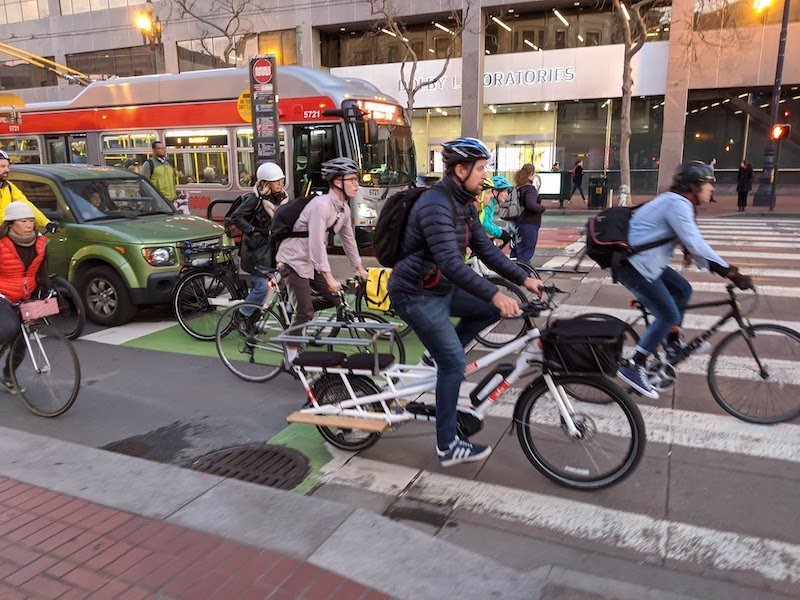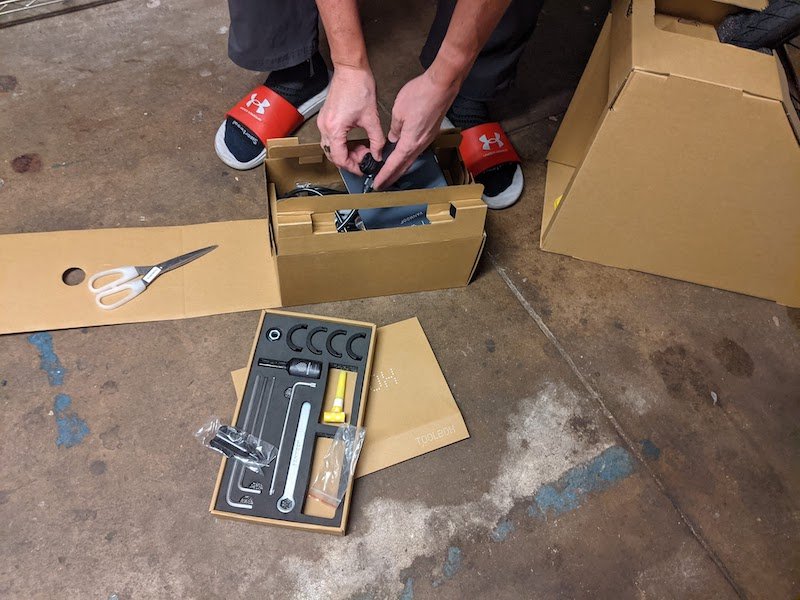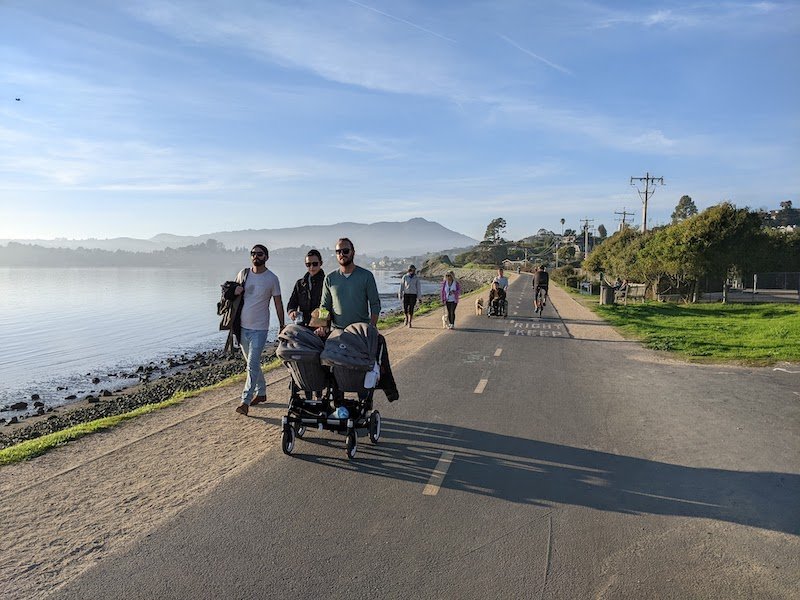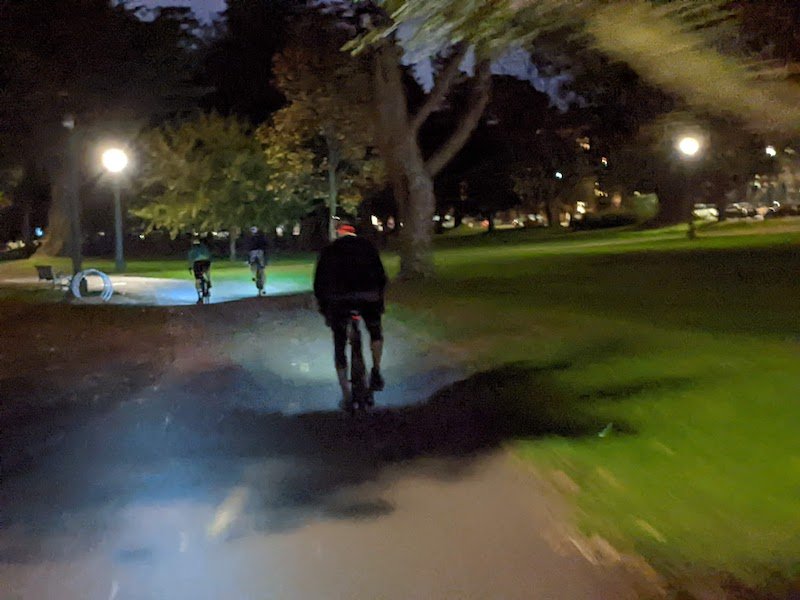Muffy Van Moof’s Maiden Voyage
I went to the dentist and when I returned to the bicycle rack I discovered my broken lock laying on the pavement. No bike. I looked at the security guard standing by the door, pointed, and gave him a look. He said, “Oh. That was your bike?” I gazed up at the security camera bolted to the wall above my head and realized they’re largely a form of public safety theater. Then I remembered I’d had this bike for over fifteen years and it was a miracle that it lasted so long. I actually won it at a raffle when I volunteered for the San Francisco Bicycle Coalition so, all in all, I had a good long run with it. It was a sunny day so I walked home from downtown.
I’m a big believer in multiple redundancy so I had a reserve bike to fall back on. It’s a 1980s vintage woman’s bike that I inherited from a friend. It feels like it’s made of cast iron and isn’t my preferred configuration, but it does the job. I’m a pudgy middle aged guy so I’m not racing the Tour de France any time soon. I just need to get around town.
As I wandered back home through the city from the dentist I indulged in a long anticipated purchase of an electric assist bicycle. At first I was scornful of e-bikes. They seemed like yet another application of too much technology for no apparent reason a la “the toaster with a brain” or the WiFi enabled toothbrush. The beauty of a bicycle is its simplicity. Why mess with a perfectly good arrangement?
But San Francisco has lots of hills and the difference between a fast easy bike ride vs. an arduous uphill journey is rendered moot with just a teeny tiny bit of extra oomph. In my daily trips I have a variety of options. I could walk or pedal up those hills, I could take a bus or streetcar, I could use a ride hailing service, or I could drive. The electric bike makes almost all my trips viable without a vehicle unless the weather is particularly bad or I’m carrying big heavy things. Not having to deal with traffic congestion or parking is a tremendous upgrade. And the distances I’m willing to go on a bike expanded greatly with the electric boost.
The other factor in my decision to splurge on an electric bike is the way they’re now a ubiquitous part of the landscape. They’ve exploded in popularity over the last couple of years. It’s hard to find a spot in the city where people aren’t riding around on them. Families with little kids, weekend adventurers, ordinary commuters, tourists, older folks, and even young guys who might otherwise be on motorcycles… That reassures me that over time there will be people who can service the equipment and suppliers who will be available to replace and upgrade the various components.
There’s a Van Moof store a few blocks from my home and the clerks were happy to give me a test drive and show me all the features. But when it came to the actual sale I was directed to their website. These days physical shops are about brand presence in strategic locations, not sales. Van Moof is based in the Netherlands, the bikes are manufactured in Taiwan, and thier storefronts are in Paris, Amsterdam, Berlin, Tokyo, San Francisco, New York.... The bike was ordered, shipped, and eventually arrived at my door in a big box. It was specifically designed to be self assembled by the consumer at home with a little allen wrench and some YouTube instructions with minimum fuss. I’m the least mechanical person I know and even I could put this bike together. I tend to name the inanimate objects in my life and I instantly dubbed her Muffy.
For her maiden voyage I took Muffy Van Moof out to Tiburon to the north of the city to test the battery range. My route went through my neighborhood near Dolores Park, along the Wiggle to Golden Gate Park, then across the Richmond District to the Golden Gate Bridge to Marin County. From there it was a mostly straight shot from Sausalito to Tiburon along the designated bike trail that hugs the waterfront.
The city was already fairly conducive to cycling long before the current fashion for bike infrastructure. City neighborhoods are compact, traffic is kept slow-ish on most side streets due to the narrowness of the lanes, there are intersections everywhere that require vehicles to stop frequently, etc. I’m not saying it’s perfect, but it tends to meet the minimum standard for tolerable cycling compared to most of the rest of the country. The new upgrades have taken a medium good arrangement and made it much better. Of course, the trade off is that it’s ever so slightly less convenient to drive a car in the city than it used to be given all the pedestrians and cyclists junking up the roadway. Not everyone is happy about that.
The moment you enter suburbia the built environment changes entirely and riding a bike becomes a more challenging endeavor. The roads are wide, the traffic is fast moving, intersections are death traps for those not encased in a few tons of steel and airbags. Drivers are oblivious. Evidence of bike retrofits can be found here and there like the “share the road” signs and green stripes on the edge of the eight lane arterials. These are a polite gesture, but it’s all lipstick on a pig. The suburbs are for cars. Full stop. Let it go.
Whenever I’m in places like this I get flashbacks to biking in the suburbs of my youth in southern New Jersey. It wasn’t merely the physical design of the roads that made it dangerous and unpleasant. It was the culture. Anyone not in a car was suspect. Damaged goods. Poor. Undesirable. The police stopped me all the time asking what was in my backpack and where I was heading. “Let’s see some identification.” I didn’t belong and they were there to keep tabs on me. In the end, they were right. It wasn’t my place and I left. I’m happy to let the suburbs be the suburbs without me.
While we’re on the topic, here’s why transit doesn’t work in the suburbs and why I believe it shouldn’t even be attempted in a low density auto dependent environment. Placing a shelter on the side of a busy highway next to a drainage ditch so people can wait entirely too long for a bus that may or may not ever arrive is a miserable experience. And that’s before anyone asks how someone on foot even gets to the shelter in the first place. If society is going to spend money on transit of any kind, the locations ought to be cherry picked so it has a fighting chance to be of actual value. I’m not against transit and I’m not anti suburb. I’m suggesting that some mobility options work well in one environment, but not in others.
One of the little things you notice on a bike or on foot that you might not even be aware of in a car at 60 miles per hour is the king tide. It hadn’t rained for weeks, yet there was standing water in places that shouldn’t be wet. Low lying territory is subject to sunny day floods when the sea comes up in these naturally occurring super tides. You also notice how the roadway for cars and trucks remains dry, but the bike path is a foot deep in swamp water. Then there’s the electrical substations, sewerage treatment plants, airports, and all sorts of other critical infrastructure sitting there in the marshland. If the tides ever get a little too high a bit too often they’re all in trouble. I don’t see anyone lining up to pay to fortify or relocate this stuff, although there’s plenty of bickering all around. In the end, the water always wins.
The bike path in this case is a defunct railroad right of way that was converted to recreational use. I call this the “Sunday in the park” model of bike infrastructure. People are expected to get out with their families for a bit of exercise and some fresh air, but it’s not particularly understood as a serious form of transportation. I’m not knocking it. The path is great. But I also know that it wouldn’t exist at all if the land hadn’t already been set aside in an accident of history by a dead rail company. Getting such a thing established was hard enough, but doing so from scratch if there hadn’t already been miles of existing railroad route is too much to ask from most locations.
The unpleasant portion of the journey from San Francisco to Tiburon is generally worth it given how nice the waterside stretch is along the bay. This is courtesy of an Irish immigrant named Peter Donahue circa 1884 who established the old railroad and left behind this lovely strip of redundant scenic dirt.
Back home I checked Muffy’s performance. 42 miles (67km) and the battery still had 15% charge left. I plugged her in for the night, washed up, and went to bed pleased with the whole experience. I’m now confident I can go anywhere in the city on this bike.






















































































